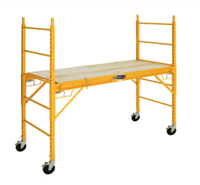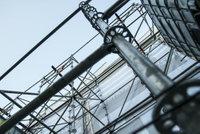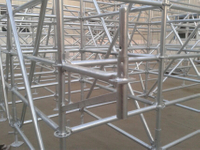There are many reasons why the construction industry uses frame scaffolding. It is more convenient and safer, and it brings great convenience to people's lives. Despite this, most people do not understand the basic common sense of frame scaffolding. For example, what type of scaffolding are there? Why are frame scaffolds more popular?
What is the type of scaffolding?
What are the advantages and disadvantages of frame scaffolding?
How to safely install frame scaffolding?
Conclusion
What is the type of scaffolding?
Frame scaffolding. One of the most common system scaffolding found on construction sites is the frame scaffolding. It is usually provided in a different configuration - the part that contains the ladder and the walk-in portal, which is actually the part of the walk and the part that looks like a ladder.
Typically, frame scaffold is created by using two portions of a stent frame that are joined by two intersecting portions of a support rod that are organized in a square shape. The new part is assembled on the front part. The workers then use these parts to reach the required height to carry out their work. Suspending the rope from the top allows the worker to pull the material to its level. Workers often perform duties from multiple levels of the frame.
Frame scaffolding is easy to erect and disassemble. It is ideal for general masonry construction, maintenance, and various exterior work such as refurbishment, restoration, cladding and support. It can also be used in building houses (facade scaffolding and load-bearing scaffolding) and for decorative works. It offers a variety of frame lock types and tube sizes as well as sturdy steel tubes. This makes it safe, reliable and efficient
System or RING-LOC scaffolding. The system or ring falsework consists of vertical columns of different sizes, as well as horizontal and diagonal tubes. Vertical columns have fixed connection points that are fast enough to connect to horizontal and diagonal tubes. The interlocking components on the system scaffolding form a standardized bracket that can accommodate a variety of structures, such as cantilevers, protective fans, saddles, and bridges to meet site requirements. Circular scaffolding is also more tolerant of higher load ratings than frame scaffolding or pipe and fixture scaffolding.
Tube and fixture scaffolding. Tube and clamp scaffolding is a fast, versatile scaffolding system that replaces or complements tubular steel scaffolding and many system scaffolding. It is a compact, easy to erect system designed for use in difficult or inaccessible locations. The pipe members are joined together by right angles and rotating clamps to build the brackets over the least uneven ground and unusual or complex shapes.
What are the advantages and disadvantages of frame scaffolding?
Advantages: 1. Higher carrying capacity. When geometry and construction scaffolding meet the relevant requirements of the specification. Single-column bearing capacity scaffolding Steel pipe brackets are flexible. Because the tube is easy to adjust the length;
2. Easy to assemble and disassemble. The fasteners are simple to connect and can therefore be applied to a variety of flat façades of buildings and structures with scaffolding. If the scaffolding geometry is well designed, the investment cost is lower.
3. More economical. Easy to handle. Pay attention to the increase in steel utilization rate and the amount of information can also achieve better economic benefits. The structural steel of the fastener steel frame is equivalent to about 15 kg per square meter.
Disadvantages: 1. The frame size is not flexible, and any change in frame size can be switched to another type of door frame and its accessories.
2. The cross support is easily broken at the hinge point.
3. The scaffolding board is heavier.
4. More expensive.
How to safely install frame scaffolding?
Two two end frames, approximately 7 feet apart, were laid near the site to begin assembly. Now slide the adjustment screw and the bottom plate or caster so you don't have to lift the entire falsework up.
Even if the basic setup procedure is the same, the frame scaffold hardware will vary from manufacturer to manufacturer. If your falsework is different from what is shown here, please ask the manufacturer for instructions.
The key to safe falsework is a solid foundation. If the floor or casters are placed on dirt, grass, asphalt or other soft material, place them on wood of 2 x 10 length to prevent them from sinking. We adjusted the wooden mat to make it flat because we didn't want to destroy the lawn by digging horizontal spots. But a better way is to level a point with a shovel before placing 2 x 10 blocks. Do not place scaffolding on loose fillers, snow or near holes or ditches.
Adjusting the screws makes the falsework smooth and safe. Never stack bricks, concrete blocks or wood chips under the frame to make them flat. If your ground slope is more than 8 feet more than a foot. Distance, renting leg extensions. Extreme slopes may require the addition of a short bracket section below one end of the falsework.
Once the scaffold is assembled and in place, double check that it is level and securely placed on
Casters allow you to easily move the falsework without unpacking it, but with some extra precautions:
Install a special horizontal support diagonally between the two outer frames to keep them square. Ask your supplier about this.
Never use tools, materials or passengers to roll falsework on wooden boards.
Lock the casters before climbing the scaffolding.
Avoid overhead wires when moving the scaffolding. If you hit the power cord, you may get an electric shock.
Do not roll scaffolding around steep slopes or ditches or holes.
Conclusion
The frame scaffolding not only ensures the rapid completion of construction work, but also ensures the safety of workers and the public on the construction site. It is therefore important to choose a qualified frame scaffolding supplier. If you want to buy durable high quality, reasonable price Frame scaffolding, Nanjing Tuopeng Construction Technology can provide you with the perfect product.



















